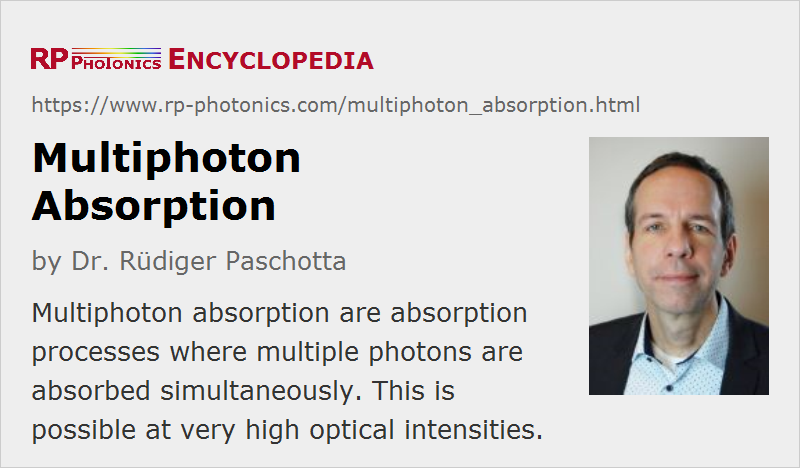Multiphoton Absorption
Definition: absorption processes where multiple photons are absorbed simultaneously
More general term: optical absorption
German: Multiphotonen-Absorption
Category:  physical foundations
physical foundations
Author: Dr. Rüdiger Paschotta
Cite the article using its DOI: https://doi.org/10.61835/o1o
Get citation code: Endnote (RIS) BibTex plain textHTML
In a dielectric materials or a semiconductor, linear electronic absorption can occur only if the photon energy is at least as large as the band gap energy. This is because the smallest amount of energy for an electronic excitations dictated by the bandgap. However, at high optical intensity it is possible to bridge that bandgap by simultaneous absorption of two or more lower-energy photons, where the sum of photon energies exceeds the bandgap energy. Such nonlinear absorption processes are called multiphoton absorption (or multi-photon absorption). The simplest variant is two-photon absorption, where only two photons are required. If the bandgap energy of a material is 2.8 times the photon energy of a laser beam, for example, only three-photon absorption and higher-order absorption processes can occur, since the photon energy is insufficient for linear and two-photon absorption.
While the absorption rate for linear absorption is simply proportional to the optical intensity, for multiphoton absorption processes of order <$n$>, the absorption rate is proportional to the <$n$>th power of the optical intensity. This implies that such absorption rates can be very small for low or moderate optical intensities, but can become dominant for very high optical intensities, as can be reached particularly with focused laser pulses. The absorption coefficient is proportional to the <$(n - 1)$>th power of the optical intensity.
Examples of Multiphoton Absorption
Multiphoton absorption processes are often involved in laser-induced damage when it occurs in transparent media. Transparency of such a medium means that linear electronic absorption is not possible for the considered optical wavelength, so that virtually no energy can be deposited by light with low optical intensity. However, multiphoton absorption can become substantial at high enough optical intensities, so that energy can be deposited, and a run-away process can start which ultimately leads to optical damage of the material. This is also exploited in laser material processing on transparent materials such as glasses.
Another example is fluorescence microscopy, where multiphoton absorption (mostly two-photon or three-photon absorption) is often utilized, where the excitation light from a femtosecond laser is strongly focused. Compared with linear excitation, the first practical advantage of multiphoton excitation is that a laser source with longer emission wavelength can be used, which is often less difficult to make because a nonlinear frequency conversion stage is not needed. A second advantage is that longer-wavelength light can more easily propagate through some depth of material without being strongly absorbed, as long as the beam radius is large enough; only in the beam focus, where the optical intensities become substantially higher, multiphoton absorption processes become strong. A third advantage is that the preferential absorption in the beam focus helps one to obtain a higher longitudinal image resolution and less interference from fluorescence light created in other planes than the image plane.
More to Learn
Encyclopedia articles:
Questions and Comments from Users
2020-11-25
In an experiment where both two-photon and three-photon absorption may occur, how can one distinguish that which experimental data comes from which process?
The author's answer:
You could see this in the dependence on the optical intensity. For two-photon absorption, the absorption coefficient grows linearly with intensity, for three-photon absorption with the square of the intensity.
2021-03-25
Following the last question: can both two-photon and three-photon absorptions occur simultaneously and result in a hybrid two-/three-photon excitation?
The author's answer:
Yes, that's possible.
Here you can submit questions and comments. As far as they get accepted by the author, they will appear above this paragraph together with the author’s answer. The author will decide on acceptance based on certain criteria. Essentially, the issue must be of sufficiently broad interest.
Please do not enter personal data here; we would otherwise delete it soon. (See also our privacy declaration.) If you wish to receive personal feedback or consultancy from the author, please contact him, e.g. via e-mail.
By submitting the information, you give your consent to the potential publication of your inputs on our website according to our rules. (If you later retract your consent, we will delete those inputs.) As your inputs are first reviewed by the author, they may be published with some delay.



2020-10-03
What are the parameters affecting the 3-photon absorption coefficient?
The author's answer:
The most essential parameter is the band gap energy. I am not sure what additional parameters of a medium you have in mind.